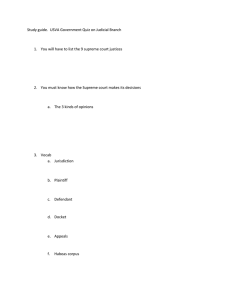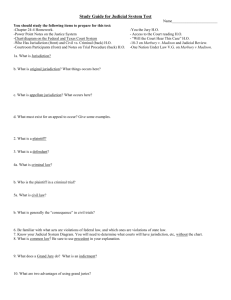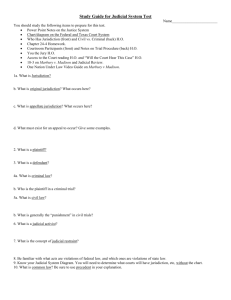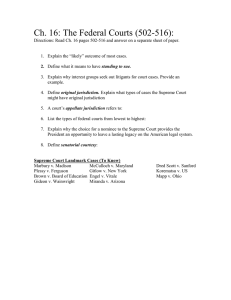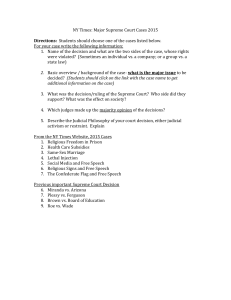– CE 8a Judicial Terms
advertisement
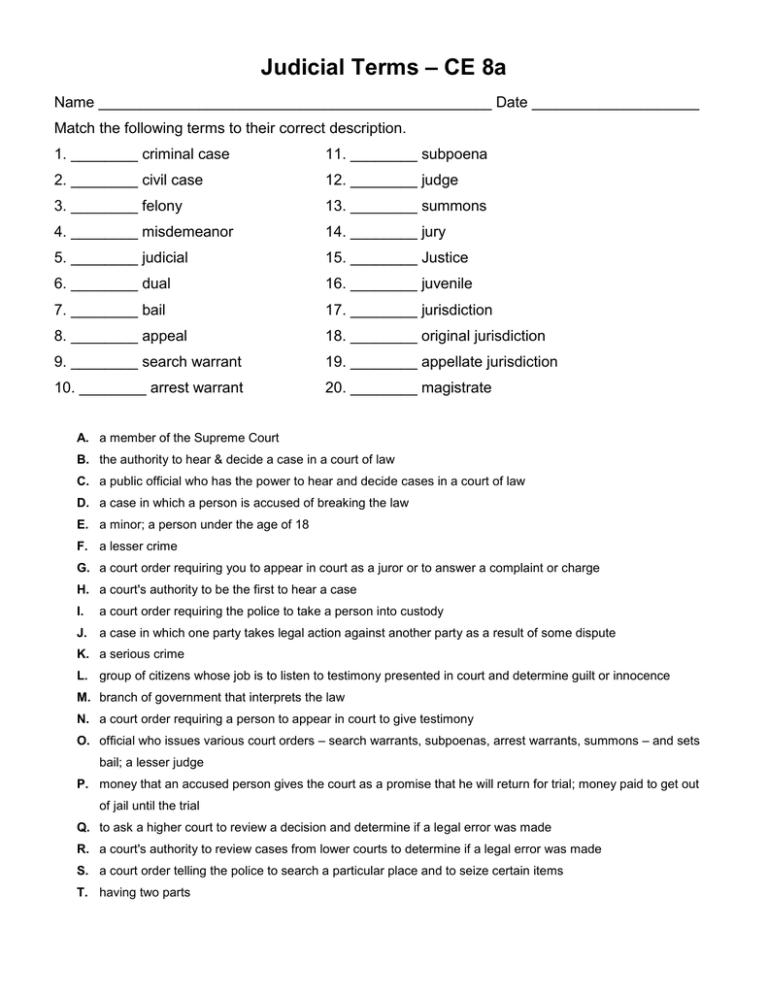
Judicial Terms – CE 8a Name _______________________________________________ Date ____________________ Match the following terms to their correct description. 1. ________ criminal case 11. ________ subpoena 2. ________ civil case 12. ________ judge 3. ________ felony 13. ________ summons 4. ________ misdemeanor 14. ________ jury 5. ________ judicial 15. ________ Justice 6. ________ dual 16. ________ juvenile 7. ________ bail 17. ________ jurisdiction 8. ________ appeal 18. ________ original jurisdiction 9. ________ search warrant 19. ________ appellate jurisdiction 10. ________ arrest warrant 20. ________ magistrate A. a member of the Supreme Court B. the authority to hear & decide a case in a court of law C. a public official who has the power to hear and decide cases in a court of law D. a case in which a person is accused of breaking the law E. a minor; a person under the age of 18 F. a lesser crime G. a court order requiring you to appear in court as a juror or to answer a complaint or charge H. a court's authority to be the first to hear a case I. a court order requiring the police to take a person into custody J. a case in which one party takes legal action against another party as a result of some dispute K. a serious crime L. group of citizens whose job is to listen to testimony presented in court and determine guilt or innocence M. branch of government that interprets the law N. a court order requiring a person to appear in court to give testimony O. official who issues various court orders – search warrants, subpoenas, arrest warrants, summons – and sets bail; a lesser judge P. money that an accused person gives the court as a promise that he will return for trial; money paid to get out of jail until the trial Q. to ask a higher court to review a decision and determine if a legal error was made R. a court's authority to review cases from lower courts to determine if a legal error was made S. a court order telling the police to search a particular place and to seize certain items T. having two parts United States Courts - CE 8a Name __________________________________________________ Date _______________ For each of the following statements decide which court is being described. Use the following abbreviations to answer the questions. DC for U.S. District Court CA for the U.S. Court of Appeals SC for the U.S. Supreme Court 1. ________ It has original jurisdiction for criminal cases under U.S. law. 2. ________ It hears appeals with groups of judges and no jury. 3. ________ Its cases are heard by a judge and jury. 4. ________ It has appellate jurisdiction and limited original jurisdiction. 5. ________ It has original jurisdiction for civil cases under U.S. law. 6. ________ Its cases are heard by all the Justices and no jury. 7. ________ It hears appeals from the District Courts. 8. ________ It is the highest court in the United States; the “court of last resort”. Judicial Review Matching - CE 8b Name _____________________________________________ Date ______________ Match the words below to their definitions by drawing a line to connect them. 1. check in violation of the Constitution 2. U.S. Supreme Court case that established the principle of judicial review 3. Virginia Supreme Court the supreme law of the land 4. unconstitutional a control or limit on another branch 5. Marbury v. Madison it has the final word on constitutionality of all U.S. laws 6. Brown v. Board of Education it has the final word on constitutionality of all state laws 7. judicial review case where judicial review was used to declare segregated schools unconstitutional 8. U.S. Constitution power of the courts to determine the constitutionality of laws and executive acts Criminal Sequencing - CE 8c Name _____________________________________________ Date ____________________ I. Steps in the Process of Criminal Justice - Use the following terms to fill in the spaces below. crime indictment appeal arraignment sentencing preliminary hearing investigation arrest booking trial 1. The process of criminal justice begins when there is a wrongful act that is against the law committed. Such an act is called a _________________________________________. 2. The next step in the process involves the police working to discover the evidence in a case. That is called the ________________________________________________. 3. Once the police have identified the suspect and they have probable cause they take the person into custody. That is called an _____________________________________________________ 4. Immediately afterward the suspect is taken to the police headquarters where an official record of the arrest is made. That is called the ________________________________________________ 5. The defendant then appears in court in what is called a ________________________________. At this time the judge decides if there is enough evidence to hold the person in custody, informs the person of his rights, and decides whether to release the him on bail. 6. Next there is a formal charge of a crime made by a grand jury. That is called an _________________________________________________________________. 7. Shortly afterward the accused person appears in court to plead guilty or not guilty. That step is called the ____________________________________________________. 8. A court date is then set and the ____________________ is held. In it the court examines the facts in the case in order to determine the truth in the matter. 9. If the defendant is found guilty he must then go through the _____________________ when the punishment for the crime is given. 10. Finally he has the right to request an ______________________, that is, a review of the case by a higher court to determine if legal mistakes were made in the trial. Ensuring Justice - CE 8d Name _________________________________________ Date ________________ Complete the selection below by choosing from the Word Bank below. All of the terms will NOT be used. WORD BANK equal protection of the law due process of law judicial review the Bill of Rights Declaration of Independence 1st Amendment 5th Amendment 10th Amendment 14th Amendment The constitutional protection against unfair governmental actions and laws is called _______________________________________. The ______________________________ prohibits the national government from acting in an unfair manner. The state and local governments are prohibited from acting in an unfair manner by the ______________________________. The U.S. Supreme Court has extended the due process clauses to protect the guarantees of ____________________________________.
